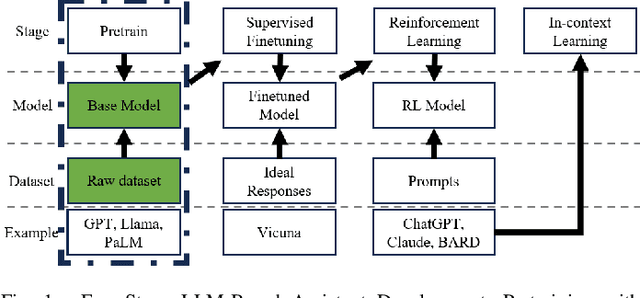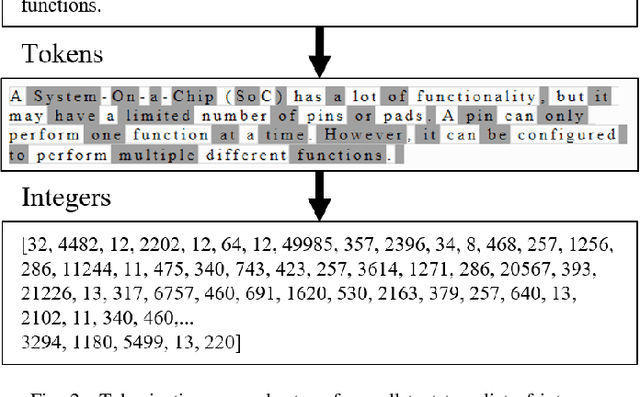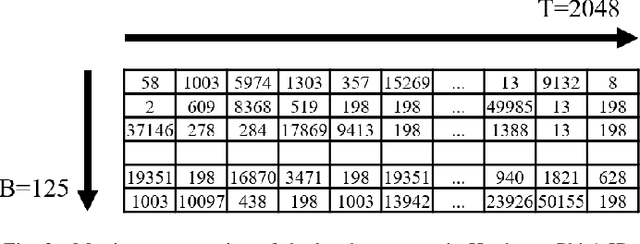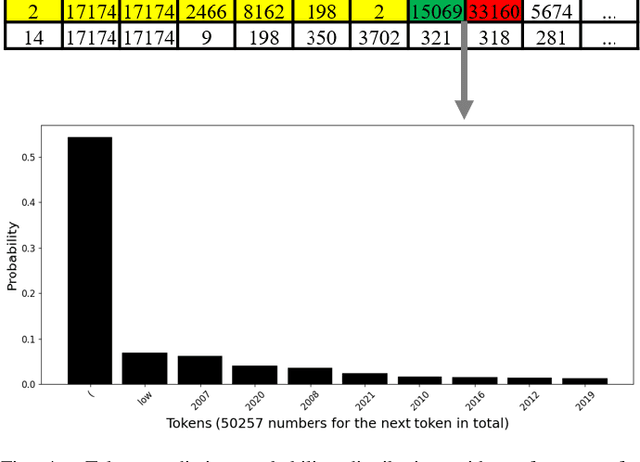Shijie Li
Multi-View Industrial Anomaly Detection with Epipolar Constrained Cross-View Fusion
Mar 14, 2025Abstract:Multi-camera systems provide richer contextual information for industrial anomaly detection. However, traditional methods process each view independently, disregarding the complementary information across viewpoints. Existing multi-view anomaly detection approaches typically employ data-driven cross-view attention for feature fusion but fail to leverage the unique geometric properties of multi-camera setups. In this work, we introduce an epipolar geometry-constrained attention module to guide cross-view fusion, ensuring more effective information aggregation. To further enhance the potential of cross-view attention, we propose a pretraining strategy inspired by memory bank-based anomaly detection. This approach encourages normal feature representations to form multiple local clusters and incorporate multi-view aware negative sample synthesis to regularize pretraining. We demonstrate that our epipolar guided multi-view anomaly detection framework outperforms existing methods on the state-of-the-art multi-view anomaly detection dataset.
Global-Aware Monocular Semantic Scene Completion with State Space Models
Mar 09, 2025Abstract:Monocular Semantic Scene Completion (MonoSSC) reconstructs and interprets 3D environments from a single image, enabling diverse real-world applications. However, existing methods are often constrained by the local receptive field of Convolutional Neural Networks (CNNs), making it challenging to handle the non-uniform distribution of projected points (Fig. \ref{fig:perspective}) and effectively reconstruct missing information caused by the 3D-to-2D projection. In this work, we introduce GA-MonoSSC, a hybrid architecture for MonoSSC that effectively captures global context in both the 2D image domain and 3D space. Specifically, we propose a Dual-Head Multi-Modality Encoder, which leverages a Transformer architecture to capture spatial relationships across all features in the 2D image domain, enabling more comprehensive 2D feature extraction. Additionally, we introduce the Frustum Mamba Decoder, built on the State Space Model (SSM), to efficiently capture long-range dependencies in 3D space. Furthermore, we propose a frustum reordering strategy within the Frustum Mamba Decoder to mitigate feature discontinuities in the reordered voxel sequence, ensuring better alignment with the scan mechanism of the State Space Model (SSM) for improved 3D representation learning. We conduct extensive experiments on the widely used Occ-ScanNet and NYUv2 datasets, demonstrating that our proposed method achieves state-of-the-art performance, validating its effectiveness. The code will be released upon acceptance.
Future-Aware Interaction Network For Motion Forecasting
Mar 09, 2025Abstract:Motion forecasting is a crucial component of autonomous driving systems, enabling the generation of accurate and smooth future trajectories to ensure safe navigation to the destination. In previous methods, potential future trajectories are often absent in the scene encoding stage, which may lead to suboptimal outcomes. Additionally, prior approaches typically employ transformer architectures for spatiotemporal modeling of trajectories and map information, which suffer from the quadratic scaling complexity of the transformer architecture. In this work, we propose an interaction-based method, named Future-Aware Interaction Network, that introduces potential future trajectories into scene encoding for a comprehensive traffic representation. Furthermore, a State Space Model (SSM), specifically Mamba, is introduced for both spatial and temporal modeling. To adapt Mamba for spatial interaction modeling, we propose an adaptive reordering strategy that transforms unordered data into a structured sequence. Additionally, Mamba is employed to refine generated future trajectories temporally, ensuring more consistent predictions. These enhancements not only improve model efficiency but also enhance the accuracy and diversity of predictions. We conduct comprehensive experiments on the widely used Argoverse 1 and Argoverse 2 datasets, demonstrating that the proposed method achieves superior performance compared to previous approaches in a more efficient way. The code will be released according to the acceptance.
SeeGround: See and Ground for Zero-Shot Open-Vocabulary 3D Visual Grounding
Dec 05, 2024Abstract:3D Visual Grounding (3DVG) aims to locate objects in 3D scenes based on textual descriptions, which is essential for applications like augmented reality and robotics. Traditional 3DVG approaches rely on annotated 3D datasets and predefined object categories, limiting scalability and adaptability. To overcome these limitations, we introduce SeeGround, a zero-shot 3DVG framework leveraging 2D Vision-Language Models (VLMs) trained on large-scale 2D data. We propose to represent 3D scenes as a hybrid of query-aligned rendered images and spatially enriched text descriptions, bridging the gap between 3D data and 2D-VLMs input formats. We propose two modules: the Perspective Adaptation Module, which dynamically selects viewpoints for query-relevant image rendering, and the Fusion Alignment Module, which integrates 2D images with 3D spatial descriptions to enhance object localization. Extensive experiments on ScanRefer and Nr3D demonstrate that our approach outperforms existing zero-shot methods by large margins. Notably, we exceed weakly supervised methods and rival some fully supervised ones, outperforming previous SOTA by 7.7% on ScanRefer and 7.1% on Nr3D, showcasing its effectiveness.
GALLa: Graph Aligned Large Language Models for Improved Source Code Understanding
Sep 06, 2024Abstract:Programming languages possess rich semantic information such as data flow that is represented by graphs and not available from the surface form of source code. Recent code language models have scaled to billions of parameters, but model source code solely as text tokens while ignoring any other structural information. Conversely, models that do encode structural information of code make modifications to the Transformer architecture, limiting their scale and compatibility with pretrained LLMs. In this work, we take the best of both worlds with GALLa - Graph Aligned Large Language Model. GALLa utilizes graph neural networks and cross-modal alignment technologies to inject the structural information of code into LLMs as an auxiliary task during finetuning. This framework is both model-agnostic and task-agnostic, as it can be applied to any code LLM for any code downstream task, and requires the structural graph data only at training time from a corpus unrelated to the finetuning data, while incurring no cost at inference time over the baseline LLM. Experiments on five code tasks with four different baseline LLMs ranging in size from 350M to 8B validate the effectiveness of GALLa, demonstrating consistent improvement over the baseline, even for powerful models such as LLaMA3.
Hardware Phi-1.5B: A Large Language Model Encodes Hardware Domain Specific Knowledge
Jan 27, 2024



Abstract:In the rapidly evolving semiconductor industry, where research, design, verification, and manufacturing are intricately linked, the potential of Large Language Models to revolutionize hardware design and security verification is immense. The primary challenge, however, lies in the complexity of hardware specific issues that are not adequately addressed by the natural language or software code knowledge typically acquired during the pretraining stage. Additionally, the scarcity of datasets specific to the hardware domain poses a significant hurdle in developing a foundational model. Addressing these challenges, this paper introduces Hardware Phi 1.5B, an innovative large language model specifically tailored for the hardware domain of the semiconductor industry. We have developed a specialized, tiered dataset comprising small, medium, and large subsets and focused our efforts on pretraining using the medium dataset. This approach harnesses the compact yet efficient architecture of the Phi 1.5B model. The creation of this first pretrained, hardware domain specific large language model marks a significant advancement, offering improved performance in hardware design and verification tasks and illustrating a promising path forward for AI applications in the semiconductor sector.
* 6 pages, 6 figures
VaLID: Variable-Length Input Diffusion for Novel View Synthesis
Dec 14, 2023Abstract:Novel View Synthesis (NVS), which tries to produce a realistic image at the target view given source view images and their corresponding poses, is a fundamental problem in 3D Vision. As this task is heavily under-constrained, some recent work, like Zero123, tries to solve this problem with generative modeling, specifically using pre-trained diffusion models. Although this strategy generalizes well to new scenes, compared to neural radiance field-based methods, it offers low levels of flexibility. For example, it can only accept a single-view image as input, despite realistic applications often offering multiple input images. This is because the source-view images and corresponding poses are processed separately and injected into the model at different stages. Thus it is not trivial to generalize the model into multi-view source images, once they are available. To solve this issue, we try to process each pose image pair separately and then fuse them as a unified visual representation which will be injected into the model to guide image synthesis at the target-views. However, inconsistency and computation costs increase as the number of input source-view images increases. To solve these issues, the Multi-view Cross Former module is proposed which maps variable-length input data to fix-size output data. A two-stage training strategy is introduced to further improve the efficiency during training time. Qualitative and quantitative evaluation over multiple datasets demonstrates the effectiveness of the proposed method against previous approaches. The code will be released according to the acceptance.
Self-supervised OCT Image Denoising with Slice-to-Slice Registration and Reconstruction
Dec 08, 2023



Abstract:Strong speckle noise is inherent to optical coherence tomography (OCT) imaging and represents a significant obstacle for accurate quantitative analysis of retinal structures which is key for advances in clinical diagnosis and monitoring of disease. Learning-based self-supervised methods for structure-preserving noise reduction have demonstrated superior performance over traditional methods but face unique challenges in OCT imaging. The high correlation of voxels generated by coherent A-scan beams undermines the efficacy of self-supervised learning methods as it violates the assumption of independent pixel noise. We conduct experiments demonstrating limitations of existing models due to this independence assumption. We then introduce a new end-to-end self-supervised learning framework specifically tailored for OCT image denoising, integrating slice-by-slice training and registration modules into one network. An extensive ablation study is conducted for the proposed approach. Comparison to previously published self-supervised denoising models demonstrates improved performance of the proposed framework, potentially serving as a preprocessing step towards superior segmentation performance and quantitative analysis.
Semantic RGB-D Image Synthesis
Aug 22, 2023Abstract:Collecting diverse sets of training images for RGB-D semantic image segmentation is not always possible. In particular, when robots need to operate in privacy-sensitive areas like homes, the collection is often limited to a small set of locations. As a consequence, the annotated images lack diversity in appearance and approaches for RGB-D semantic image segmentation tend to overfit the training data. In this paper, we thus introduce semantic RGB-D image synthesis to address this problem. It requires synthesising a realistic-looking RGB-D image for a given semantic label map. Current approaches, however, are uni-modal and cannot cope with multi-modal data. Indeed, we show that extending uni-modal approaches to multi-modal data does not perform well. In this paper, we therefore propose a generator for multi-modal data that separates modal-independent information of the semantic layout from the modal-dependent information that is needed to generate an RGB and a depth image, respectively. Furthermore, we propose a discriminator that ensures semantic consistency between the label maps and the generated images and perceptual similarity between the real and generated images. Our comprehensive experiments demonstrate that the proposed method outperforms previous uni-modal methods by a large margin and that the accuracy of an approach for RGB-D semantic segmentation can be significantly improved by mixing real and generated images during training.
Microscopy Image Segmentation via Point and Shape Regularized Data Synthesis
Aug 18, 2023Abstract:Current deep learning-based approaches for the segmentation of microscopy images heavily rely on large amount of training data with dense annotation, which is highly costly and laborious in practice. Compared to full annotation where the complete contour of objects is depicted, point annotations, specifically object centroids, are much easier to acquire and still provide crucial information about the objects for subsequent segmentation. In this paper, we assume access to point annotations only during training and develop a unified pipeline for microscopy image segmentation using synthetically generated training data. Our framework includes three stages: (1) it takes point annotations and samples a pseudo dense segmentation mask constrained with shape priors; (2) with an image generative model trained in an unpaired manner, it translates the mask to a realistic microscopy image regularized by object level consistency; (3) the pseudo masks along with the synthetic images then constitute a pairwise dataset for training an ad-hoc segmentation model. On the public MoNuSeg dataset, our synthesis pipeline produces more diverse and realistic images than baseline models while maintaining high coherence between input masks and generated images. When using the identical segmentation backbones, the models trained on our synthetic dataset significantly outperform those trained with pseudo-labels or baseline-generated images. Moreover, our framework achieves comparable results to models trained on authentic microscopy images with dense labels, demonstrating its potential as a reliable and highly efficient alternative to labor-intensive manual pixel-wise annotations in microscopy image segmentation. The code is available.
 Add to Chrome
Add to Chrome Add to Firefox
Add to Firefox Add to Edge
Add to Edge